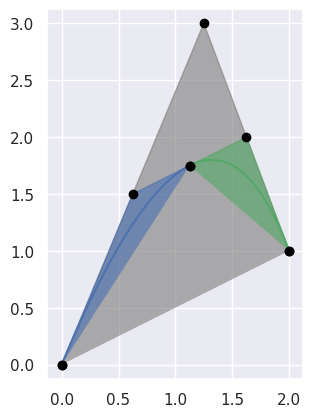curve module¶
This is a collection of procedures for performing computations on a Bézier curve.
Procedures¶
-
void
BEZ_compute_length(const int *num_nodes, const int *dimension, const double *nodes, double *length, int *error_val)¶ Computes the length of a Bézier curve via
\[\ell = \int_0^1 \left\lVert B'(s) \right\rVert \, ds.\]- Parameters
num_nodes (const int*) – [Input] The number of control points \(N\) of a Bézier curve.
dimension (const int*) – [Input] The dimension \(D\) such that the curve lies in \(\mathbf{R}^D\).
nodes (const double*) – [Input] The actual control points of the curve as a \(D \times N\) array. This should be laid out in Fortran order, with \(D N\) total values.
length (double*) – [Output] The computed length \(\ell\).
error_val (int*) – [Output] An error status passed along from
dqagse(a QUADPACK procedure).
Signature:
void BEZ_compute_length(const int *num_nodes, const int *dimension, const double *nodes, double *length, int *error_val);
Example:
// Inputs. int num_nodes = 2; int dimension = 2; double nodes[4] = { 0.0, 0.0, 3.0, 4.0 }; // Outputs. double length; int error_val; BEZ_compute_length(&num_nodes, &dimension, nodes, &length, &error_val); printf("Length: %f\n", length); printf("Error value: %d\n", error_val);
Consider the line segment \(B(s) = \left[\begin{array}{c} 3s \\ 4s \end{array}\right]\), we can verify the length:
$ INCLUDE_DIR=.../libbezier-release/usr/include $ LIB_DIR=.../libbezier-release/usr/lib $ gcc \ > -o example \ > example_compute_length.c \ > -I "${INCLUDE_DIR}" \ > -L "${LIB_DIR}" \ > -Wl,-rpath,"${LIB_DIR}" \ > -lbezier \ > -lm -lgfortran $ ./example Length: 5.000000 Error value: 0
-
void
BEZ_elevate_nodes_curve(const int *num_nodes, const int *dimension, const double *nodes, double *elevated)¶ Degree-elevate a Bézier curve. Does so by producing control points of a higher degree that define the exact same curve.
See
Curve.elevate()for more details.- Parameters
num_nodes (const int*) – [Input] The number of control points \(N\) of a Bézier curve.
dimension (const int*) – [Input] The dimension \(D\) such that the curve lies in \(\mathbf{R}^D\).
nodes (const double*) – [Input] The actual control points of the curve as a \(D \times N\) array. This should be laid out in Fortran order, with \(D N\) total values.
elevated (double*) – [Output] The control points of the degree-elevated curve as a \(D \times (N + 1)\) array, laid out in Fortran order.
Signature:
void BEZ_elevate_nodes_curve(const int *num_nodes, const int *dimension, const double *nodes, double *elevated);
Example:
After elevating \(B(s) = \left[\begin{array}{c} 0 \\ 0 \end{array}\right] (1 - s)^2 + \frac{1}{2} \left[\begin{array}{c} 3 \\ 3 \end{array}\right] 2 (1 - s) s + \left[\begin{array}{c} 3 \\ 0 \end{array}\right] s^2\):
// Inputs. int num_nodes = 3; int dimension = 2; double nodes[6] = { 0.0, 0.0, 1.5, 1.5, 3.0, 0.0 }; // Outputs. double elevated[8]; BEZ_elevate_nodes_curve(&num_nodes, &dimension, nodes, elevated); printf("Elevated:\n"); printf("%f, %f, %f, %f\n", elevated[0], elevated[2], elevated[4], elevated[6]); printf("%f, %f, %f, %f\n", elevated[1], elevated[3], elevated[5], elevated[7]);
we have \(B(s) = \left[\begin{array}{c} 0 \\ 0 \end{array}\right] (1 - s)^3 + \left[\begin{array}{c} 1 \\ 1 \end{array}\right] 3 (1 - s)^2 s + \left[\begin{array}{c} 2 \\ 1 \end{array}\right] 3 (1 - s) s^2 + \left[\begin{array}{c} 3 \\ 0 \end{array}\right] s^3\):
$ INCLUDE_DIR=.../libbezier-release/usr/include $ LIB_DIR=.../libbezier-release/usr/lib $ gcc \ > -o example \ > example_elevate_nodes_curve.c \ > -I "${INCLUDE_DIR}" \ > -L "${LIB_DIR}" \ > -Wl,-rpath,"${LIB_DIR}" \ > -lbezier \ > -lm -lgfortran $ ./example Elevated: 0.000000, 1.000000, 2.000000, 3.000000 0.000000, 1.000000, 1.000000, 0.000000
-
void
BEZ_evaluate_curve_barycentric(const int *num_nodes, const int *dimension, const double *nodes, const int *num_vals, const double *lambda1, const double *lambda2, double *evaluated)¶ For a Bézier curve with control points \(p_0, \ldots, p_d\), this evaluates the quantity
\[Q(\lambda_1, \lambda_2) = \sum_{j = 0}^d \binom{d}{j} \lambda_1^{d - j} \lambda_2^j p_j.\]The typical case is barycentric, i.e. \(\lambda_1 + \lambda_2 = 1\), but this is not required.
- Parameters
num_nodes (const int*) – [Input] The number of control points \(N\) of a Bézier curve.
dimension (const int*) – [Input] The dimension \(D\) such that the curve lies in \(\mathbf{R}^D\).
nodes (const double*) – [Input] The actual control points of the curve as a \(D \times N\) array. This should be laid out in Fortran order, with \(D N\) total values.
num_vals (const int*) – [Input] The number of values \(k\) where the quantity will be evaluated.
lambda1 (const double*) – [Input] An array of \(k\) values used for the first parameter \(\lambda_1\).
lambda2 (const double*) – [Input] An array of \(k\) values used for the second parameter \(\lambda_2\).
evaluated (double*) – [Output] The evaluated quantites as a \(D \times k\) array, laid out in Fortran order. Column \(j\) of
evaluatedwill contain \(Q\left(\lambda_1\left[j\right], \lambda_2\left[j\right]\right)\).
Signature:
void BEZ_evaluate_curve_barycentric(const int *num_nodes, const int *dimension, const double *nodes, const int *num_vals, const double *lambda1, const double *lambda2, double *evaluated);
Example:
For the curve \(B(s) = \left[\begin{array}{c} 0 \\ 1 \end{array}\right] (1 - s)^2 + \left[\begin{array}{c} 2 \\ 1 \end{array}\right] 2 (1 - s) s + \left[\begin{array}{c} 3 \\ 3 \end{array}\right] s^2 = \left[\begin{array}{c} s(4 - s) \\ 2s^2 + 1 \end{array}\right]\):
// Inputs. int num_nodes = 3; int dimension = 2; double nodes[6] = { 0.0, 1.0, 2.0, 1.0, 3.0, 3.0 }; int num_vals = 4; double lambda1[4] = { 0.25, 0.5, 0.0, 1.0 }; double lambda2[4] = { 0.75, 0.25, 0.5, 0.25 }; // Outputs. double evaluated[8]; BEZ_evaluate_curve_barycentric( &num_nodes, &dimension, nodes, &num_vals, lambda1, lambda2, evaluated); printf("Evaluated:\n"); printf("%f, %f, %f, %f\n", evaluated[0], evaluated[2], evaluated[4], evaluated[6]); printf("%f, %f, %f, %f\n", evaluated[1], evaluated[3], evaluated[5], evaluated[7]);
we have
\[\begin{split}\begin{align*} Q\left(\frac{1}{4}, \frac{3}{4}\right) &= \frac{1}{16} \left[ \begin{array}{c} 39 \\ 34 \end{array}\right] \\ Q\left(\frac{1}{2}, \frac{1}{4}\right) &= \frac{1}{16} \left[ \begin{array}{c} 11 \\ 11 \end{array}\right] \\ Q\left(0, \frac{1}{2}\right) &= \frac{1}{4} \left[ \begin{array}{c} 3 \\ 3 \end{array}\right] \\ Q\left(1, \frac{1}{4}\right) &= \frac{1}{16} \left[ \begin{array}{c} 19 \\ 27 \end{array}\right] \end{align*}\end{split}\]$ INCLUDE_DIR=.../libbezier-release/usr/include $ LIB_DIR=.../libbezier-release/usr/lib $ gcc \ > -o example \ > example_evaluate_curve_barycentric.c \ > -I "${INCLUDE_DIR}" \ > -L "${LIB_DIR}" \ > -Wl,-rpath,"${LIB_DIR}" \ > -lbezier \ > -lm -lgfortran $ ./example Evaluated: 2.437500, 0.687500, 0.750000, 1.187500 2.125000, 0.687500, 0.750000, 1.687500
-
void
BEZ_evaluate_hodograph(const double *s, const int *num_nodes, const int *dimension, const double *nodes, double *hodograph)¶ Evaluates the hodograph (or derivative) of a Bézier curve function \(B'(s)\).
- Parameters
s (const double*) – [Input] The parameter \(s\) where the hodograph is being computed.
num_nodes (const int*) – [Input] The number of control points \(N\) of a Bézier curve.
dimension (const int*) – [Input] The dimension \(D\) such that the curve lies in \(\mathbf{R}^D\).
nodes (const double*) – [Input] The actual control points of the curve as a \(D \times N\) array. This should be laid out in Fortran order, with \(D N\) total values.
hodograph (double*) – [Output] The hodograph \(B'(s)\) as a \(D \times 1\) array.
Signature:
void BEZ_evaluate_hodograph(const double *s, const int *num_nodes, const int *dimension, const double *nodes, double *hodograph);
Example:
For the curve \(B(s) = \left[\begin{array}{c} 1 \\ 0 \end{array}\right] (1 - s)^3 + \left[\begin{array}{c} 1 \\ 1 \end{array}\right] 3 (1 - s)^2 s + \left[\begin{array}{c} 2 \\ 0 \end{array}\right] 3 (1 - s) s^2 + \left[\begin{array}{c} 2 \\ 1 \end{array}\right] s^3\):
// Inputs. double s = 0.125; int num_nodes = 4; int dimension = 2; double nodes[8] = { 1.0, 0.0, 1.0, 1.0, 2.0, 0.0, 2.0, 1.0 }; // Outputs. double hodograph[2]; BEZ_evaluate_hodograph(&s, &num_nodes, &dimension, nodes, hodograph); printf("Hodograph:\n%f\n%f\n", hodograph[0], hodograph[1]);
we have \(B'\left(\frac{1}{8}\right) = \frac{1}{32} \left[ \begin{array}{c} 21 \\ 54 \end{array}\right]\):
$ INCLUDE_DIR=.../libbezier-release/usr/include $ LIB_DIR=.../libbezier-release/usr/lib $ gcc \ > -o example \ > example_evaluate_hodograph.c \ > -I "${INCLUDE_DIR}" \ > -L "${LIB_DIR}" \ > -Wl,-rpath,"${LIB_DIR}" \ > -lbezier \ > -lm -lgfortran $ ./example Hodograph: 0.656250 1.687500
-
void
BEZ_evaluate_multi(const int *num_nodes, const int *dimension, const double *nodes, const int *num_vals, const double *s_vals, double *evaluated)¶ Evaluate a Bézier curve function \(B(s_j)\) at multiple values \(\left\{s_j\right\}_j\).
- Parameters
num_nodes (const int*) – [Input] The number of control points \(N\) of a Bézier curve.
dimension (const int*) – [Input] The dimension \(D\) such that the curve lies in \(\mathbf{R}^D\).
nodes (const double*) – [Input] The actual control points of the curve as a \(D \times N\) array. This should be laid out in Fortran order, with \(D N\) total values.
num_vals (const int*) – [Input] The number of values \(k\) where the \(B(s)\) will be evaluated.
s_vals (const double*) – [Input] An array of \(k\) values \(s_j\).
evaluated (double*) – [Output] The evaluated points as a \(D \times k\) array, laid out in Fortran order. Column \(j\) of
evaluatedwill contain \(B\left(s_j\right)\).
Signature:
void BEZ_evaluate_multi(const int *num_nodes, const int *dimension, const double *nodes, const int *num_vals, const double *s_vals, double *evaluated);
Example:
For the curve \(B(s) = \left[\begin{array}{c} 1 \\ 0 \end{array}\right] (1 - s)^3 + \left[\begin{array}{c} 1 \\ 1 \end{array}\right] 3 (1 - s)^2 s + \left[\begin{array}{c} 2 \\ 0 \end{array}\right] 3 (1 - s) s^2 + \left[\begin{array}{c} 2 \\ 1 \end{array}\right] s^3\):
// Inputs. int num_nodes = 4; int dimension = 2; double nodes[8] = { 1.0, 0.0, 1.0, 1.0, 2.0, 0.0, 2.0, 1.0 }; int num_vals = 3; double s_vals[3] = { 0.0, 0.5, 1.0 }; // Outputs. double evaluated[6]; BEZ_evaluate_multi( &num_nodes, &dimension, nodes, &num_vals, s_vals, evaluated); printf("Evaluated:\n"); printf("%f, %f, %f\n", evaluated[0], evaluated[2], evaluated[4]); printf("%f, %f, %f\n", evaluated[1], evaluated[3], evaluated[5]);
we have \(B\left(0\right) = \left[\begin{array}{c} 1 \\ 0 \end{array}\right], B\left(\frac{1}{2}\right) = \frac{1}{2} \left[\begin{array}{c} 3 \\ 1 \end{array}\right]\) and \(B\left(1\right) = \left[\begin{array}{c} 2 \\ 1 \end{array}\right]\):
$ INCLUDE_DIR=.../libbezier-release/usr/include $ LIB_DIR=.../libbezier-release/usr/lib $ gcc \ > -o example \ > example_evaluate_multi.c \ > -I "${INCLUDE_DIR}" \ > -L "${LIB_DIR}" \ > -Wl,-rpath,"${LIB_DIR}" \ > -lbezier \ > -lm -lgfortran $ ./example Evaluated: 1.000000, 1.500000, 2.000000 0.000000, 0.500000, 1.000000
-
void
BEZ_full_reduce(const int *num_nodes, const int *dimension, const double *nodes, const int *num_reduced_nodes, double *reduced, bool *not_implemented)¶ Perform a “full” degree reduction. Does so by using
BEZ_reduce_pseudo_inverse()continually until the degree of the curve can no longer be reduced.- Parameters
num_nodes (const int*) – [Input] The number of control points \(N\) of a Bézier curve.
dimension (const int*) – [Input] The dimension \(D\) such that the curve lies in \(\mathbf{R}^D\).
nodes (const double*) – [Input] The actual control points of the curve as a \(D \times N\) array. This should be laid out in Fortran order, with \(D N\) total values.
num_reduced_nodes (const int*) – [Output] The number of control points \(M\) of the fully reduced curve.
reduced (double*) – [Output] The control points of the fully reduced curve as a \(D \times N\) array. The first \(M\) columns will contain the reduced nodes.
reducedmust be allocated by the caller and since \(M = N\) occurs when no reduction is possible, this array must be \(D \times N\).not_implemented (bool*) – [Output] Indicates if degree-reduction has been implemented for the current curve’s degree. (Currently, the only degrees supported are 1, 2, 3 and 4.)
Signature:
void BEZ_full_reduce(const int *num_nodes, const int *dimension, const double *nodes, const int *num_reduced_nodes, double *reduced, bool *not_implemented);
Example:
When taking a curve that is degree-elevated from linear to quartic:
// Inputs. int num_nodes = 5; int dimension = 2; double nodes[10] = { 1.0, 3.0, 1.25, 3.5, 1.5, 4.0, 1.75, 4.5, 2.0, 5.0 }; // Outputs. int num_reduced_nodes; double reduced[10]; bool not_implemented; BEZ_full_reduce(&num_nodes, &dimension, nodes, &num_reduced_nodes, reduced, ¬_implemented); printf("Number of reduced nodes: %d\n", num_reduced_nodes); printf("Reduced:\n"); printf("%f, %f\n", reduced[0], reduced[2]); printf("%f, %f\n", reduced[1], reduced[3]); printf("Not implemented: %s\n", not_implemented ? "TRUE" : "FALSE");
this procedure reduces it to the line \(B(s) = \left[\begin{array}{c} 1 \\ 3 \end{array}\right] (1 - s) + \left[\begin{array}{c} 2 \\ 5 \end{array}\right] s = \left[\begin{array}{c} 1 + s \\ 3 + 2s \end{array}\right]\):
$ INCLUDE_DIR=.../libbezier-release/usr/include $ LIB_DIR=.../libbezier-release/usr/lib $ gcc \ > -o example \ > example_full_reduce.c \ > -I "${INCLUDE_DIR}" \ > -L "${LIB_DIR}" \ > -Wl,-rpath,"${LIB_DIR}" \ > -lbezier \ > -lm -lgfortran $ ./example Number of reduced nodes: 2 Reduced: 1.000000, 2.000000 3.000000, 5.000000 Not implemented: FALSE
-
void
BEZ_get_curvature(const int *num_nodes, const double *nodes, const double *tangent_vec, const double *s, double *curvature)¶ Get the signed curvature of a Bézier curve at a point. See
hazmat.curve_helpers.get_curvature()for more details.Note
This only computes curvature for plane curves (i.e. curves in \(\mathbf{R}^2\)). An equivalent notion of curvature exists for space curves, but support for that is not implemented here.
- Parameters
num_nodes (const int*) – [Input] The number of control points \(N\) of a Bézier curve.
nodes (const double*) – [Input] The actual control points of the curve as a \(2 \times N\) array. This should be laid out in Fortran order, with \(2 N\) total values.
tangent_vec (const double*) – [Input] The hodograph \(B'(s)\) as a \(2 \times 1\) array. Note that this could be computed once \(s\) and \(B\) are known, but this allows the caller to re-use an already computed tangent vector.
s (const double*) – [Input] The parameter \(s\) where the curvature is being computed.
curvature (double*) – [Output] The signed curvature \(\kappa\).
Signature:
void BEZ_get_curvature(const int *num_nodes, const double *nodes, const double *tangent_vec, const double *s, double *curvature);
Example:
// Inputs. int num_nodes = 5; double nodes[10] = { 1.0, 0.0, 0.75, 2.0, 0.5, -2.0, 0.25, 2.0, 0.0, 0.0 }; double tangent_vec[2] = { -1.0, 0.0 }; double s = 0.5; // Outputs. double curvature; BEZ_get_curvature(&num_nodes, nodes, tangent_vec, &s, &curvature); printf("Curvature: %f\n", curvature);
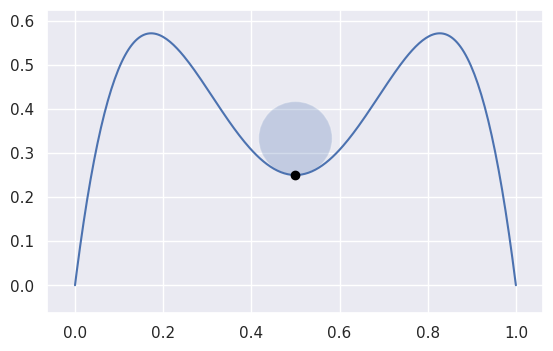
$ INCLUDE_DIR=.../libbezier-release/usr/include $ LIB_DIR=.../libbezier-release/usr/lib $ gcc \ > -o example \ > example_get_curvature.c \ > -I "${INCLUDE_DIR}" \ > -L "${LIB_DIR}" \ > -Wl,-rpath,"${LIB_DIR}" \ > -lbezier \ > -lm -lgfortran $ ./example Curvature: -12.000000
-
void
BEZ_locate_point_curve(const int *num_nodes, const int *dimension, const double *nodes, const double *point, double *s_approx)¶ This solves the inverse problem \(B(s) = p\) (if it can be solved). Does so by subdividing the curve until the segments are sufficiently small, then using Newton’s method to narrow in on the pre-image of the point.
- Parameters
num_nodes (const int*) – [Input] The number of control points \(N\) of a Bézier curve.
dimension (const int*) – [Input] The dimension \(D\) such that the curve lies in \(\mathbf{R}^D\).
nodes (const double*) – [Input] The actual control points of the curve as a \(D \times N\) array. This should be laid out in Fortran order, with \(D N\) total values.
point (const double*) – [Input] The point \(p\) as a \(D \times 1\) array.
s_approx (double*) – [Output] The parameter \(s\) of the solution. If \(p\) can’t be located on the curve, then
s_approx = -1.0. If there are multiple parameters that satisfy \(B(s) = p\) (indicating that \(B(s)\) has a self-crossing) thens_approx = -2.0.
Signature:
void BEZ_locate_point_curve(const int *num_nodes, const int *dimension, const double *nodes, const double *point, double *s_approx);
Example:
For \(B(s) = \left[\begin{array}{c} 0 \\ 2 \end{array}\right] (1 - s)^3 + \left[\begin{array}{c} -1 \\ 0 \end{array}\right] 3 (1 - s)^2 s + \left[\begin{array}{c} 1 \\ 1 \end{array}\right] 3 (1 - s) s^2 + \frac{1}{8} \left[\begin{array}{c} -6 \\ 13 \end{array}\right] s^3\):
// Inputs. int num_nodes = 4; int dimension = 2; double nodes[8] = { 0.0, 2.0, -1.0, 0.0, 1.0, 1.0, -0.75, 1.625 }; double point1[2] = { -0.09375, 0.828125 }; double point2[2] = { 0.0, 1.5 }; double point3[2] = { -0.25, 1.375 }; // Outputs. double s_approx; BEZ_locate_point_curve(&num_nodes, &dimension, nodes, point1, &s_approx); printf("When B(s) = [% f, %f]; s = % f\n", point1[0], point1[1], s_approx); BEZ_locate_point_curve(&num_nodes, &dimension, nodes, point2, &s_approx); printf("When B(s) = [% f, %f]; s = % f\n", point2[0], point2[1], s_approx); BEZ_locate_point_curve(&num_nodes, &dimension, nodes, point3, &s_approx); printf("When B(s) = [% f, %f]; s = % f\n", point3[0], point3[1], s_approx);
We can locate the point \(B\left(\frac{1}{2}\right) = \frac{1}{64} \left[\begin{array}{c} -6 \\ 53 \end{array}\right]\) but find that \(\frac{1}{2} \left[\begin{array}{c} 0 \\ 3 \end{array}\right]\) is not on the curve and that
\[\begin{split}B\left(\frac{3 - \sqrt{5}}{6}\right) = B\left(\frac{3 + \sqrt{5}}{6}\right) = \frac{1}{8} \left[ \begin{array}{c} -2 \\ 11 \end{array}\right]\end{split}\]is a self-crossing:
$ INCLUDE_DIR=.../libbezier-release/usr/include $ LIB_DIR=.../libbezier-release/usr/lib $ gcc \ > -o example \ > example_locate_point_curve.c \ > -I "${INCLUDE_DIR}" \ > -L "${LIB_DIR}" \ > -Wl,-rpath,"${LIB_DIR}" \ > -lbezier \ > -lm -lgfortran $ ./example When B(s) = [-0.093750, 0.828125]; s = 0.500000 When B(s) = [ 0.000000, 1.500000]; s = -1.000000 When B(s) = [-0.250000, 1.375000]; s = -2.000000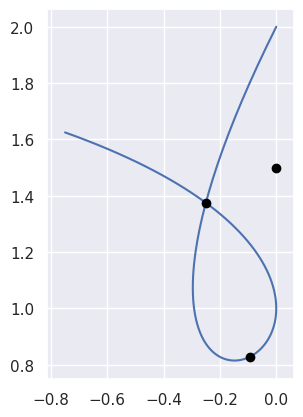
-
void
BEZ_newton_refine_curve(const int *num_nodes, const int *dimension, const double *nodes, const double *point, const double *s, double *updated_s)¶ This refines a solution to \(B(s) = p\) using Newton’s method. Given a current approximation \(s_n\) for a solution, this produces the updated approximation via
\[s_{n + 1} = s_n - \frac{B'(s_n)^T \left[B(s_n) - p\right]}{ B'(s_n)^T B'(s_n)}.\]- Parameters
num_nodes (const int*) – [Input] The number of control points \(N\) of a Bézier curve.
dimension (const int*) – [Input] The dimension \(D\) such that the curve lies in \(\mathbf{R}^D\).
nodes (const double*) – [Input] The actual control points of the curve as a \(D \times N\) array. This should be laid out in Fortran order, with \(D N\) total values.
point (const double*) – [Input] The point \(p\) as a \(D \times 1\) array.
s (const double*) – [Input] The parameter \(s_n\) of the current approximation of a solution.
updated_s (double*) – [Output] The parameter \(s_{n + 1}\) of the updated approximation.
Signature:
void BEZ_newton_refine_curve(const int *num_nodes, const int *dimension, const double *nodes, const double *point, const double *s, double *updated_s);
Example:
When trying to locate \(B\left(\frac{1}{4}\right) = \frac{1}{16} \left[\begin{array}{c} 9 \\ 13 \end{array}\right]\) on the curve \(B(s) = \left[\begin{array}{c} 0 \\ 0 \end{array}\right] (1 - s)^2 + \left[\begin{array}{c} 1 \\ 2 \end{array}\right] 2 (1 - s) s + \left[\begin{array}{c} 3 \\ 1 \end{array}\right] s^2\), starting at \(s = \frac{3}{4}\):
// Inputs. int num_nodes = 3; int dimension = 2; double nodes[6] = { 0.0, 0.0, 1.0, 2.0, 3.0, 1.0 }; double point[2] = { 0.5625, 0.8125 }; double s = 0.75; // Outputs. double updated_s; BEZ_newton_refine_curve( &num_nodes, &dimension, nodes, point, &s, &updated_s);
we expect a Newton update \(\Delta s = -\frac{2}{5}\), which produces a new parameter value \(s = \frac{7}{20}\):
$ INCLUDE_DIR=.../libbezier-release/usr/include $ LIB_DIR=.../libbezier-release/usr/lib $ gcc \ > -o example \ > example_newton_refine_curve.c \ > -I "${INCLUDE_DIR}" \ > -L "${LIB_DIR}" \ > -Wl,-rpath,"${LIB_DIR}" \ > -lbezier \ > -lm -lgfortran $ ./example Updated s: 0.350000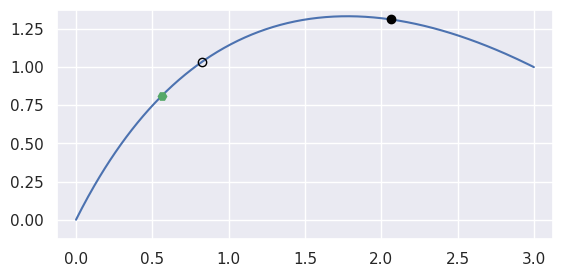
-
void
BEZ_reduce_pseudo_inverse(const int *num_nodes, const int *dimension, const double *nodes, double *reduced, bool *not_implemented)¶ Perform a pseudo inverse to
BEZ_elevate_nodes_curve(). If an inverse can be found, i.e. if a curve can be degree-reduced, then this will produce the equivalent curve of lower degree. If no inverse can be found, then this will produce the “best” answer in the least squares sense.- Parameters
num_nodes (const int*) – [Input] The number of control points \(N\) of a Bézier curve.
dimension (const int*) – [Input] The dimension \(D\) such that the curve lies in \(\mathbf{R}^D\).
nodes (const double*) – [Input] The actual control points of the curve as a \(D \times N\) array. This should be laid out in Fortran order, with \(D N\) total values.
reduced (double*) – [Output] The control points of the degree-(pseudo)reduced curve \(D \times (N - 1)\) array, laid out in Fortran order.
not_implemented (bool*) – [Output] Indicates if degree-reduction has been implemented for the current curve’s degree. (Currently, the only degrees supported are 1, 2, 3 and 4.)
Signature:
void BEZ_reduce_pseudo_inverse(const int *num_nodes, const int *dimension, const double *nodes, double *reduced, bool *not_implemented);
Example:
After reducing \(B(s) = \left[\begin{array}{c} -3 \\ 3 \end{array}\right] (1 - s)^3 + \left[\begin{array}{c} 0 \\ 2 \end{array}\right] 3 (1 - s)^2 s + \left[\begin{array}{c} 1 \\ 3 \end{array}\right] 3 (1 - s) s^2 + \left[\begin{array}{c} 0 \\ 6 \end{array}\right] s^3\):
// Inputs. int num_nodes = 4; int dimension = 2; double nodes[8] = { -3.0, 3.0, 0.0, 2.0, 1.0, 3.0, 0.0, 6.0 }; // Outputs. double reduced[6]; bool not_implemented; BEZ_reduce_pseudo_inverse( &num_nodes, &dimension, nodes, reduced, ¬_implemented); printf("Reduced:\n"); printf("% f, %f, %f\n", reduced[0], reduced[2], reduced[4]); printf("% f, %f, %f\n", reduced[1], reduced[3], reduced[5]); printf("Not implemented: %s\n", not_implemented ? "TRUE" : "FALSE");
we get the valid quadratic representation of \(B(s) = \left[\begin{array}{c} 3(1 - s)(2s - 1) \\ 3(2s^2 - s + 1) \end{array}\right]\):
$ INCLUDE_DIR=.../libbezier-release/usr/include $ LIB_DIR=.../libbezier-release/usr/lib $ gcc \ > -o example \ > example_reduce_pseudo_inverse.c \ > -I "${INCLUDE_DIR}" \ > -L "${LIB_DIR}" \ > -Wl,-rpath,"${LIB_DIR}" \ > -lbezier \ > -lm -lgfortran $ ./example Reduced: -3.000000, 1.500000, 0.000000 3.000000, 1.500000, 6.000000 Not implemented: FALSE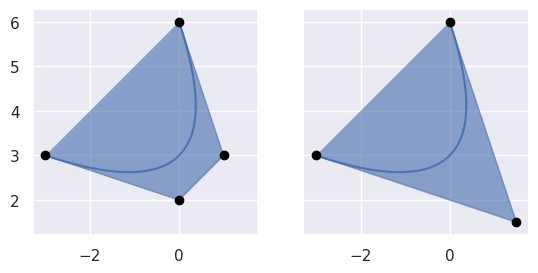
-
void
BEZ_specialize_curve(const int *num_nodes, const int *dimension, const double *nodes, const double *start, const double *end, double *new_nodes)¶ Specialize a Bézier curve to an interval \(\left[a, b\right]\). This produces the control points for the curve given by \(B\left(a + (b - a) s\right)\).
- Parameters
num_nodes (const int*) – [Input] The number of control points \(N\) of a Bézier curve.
dimension (const int*) – [Input] The dimension \(D\) such that the curve lies in \(\mathbf{R}^D\).
nodes (const double*) – [Input] The actual control points of the curve as a \(D \times N\) array. This should be laid out in Fortran order, with \(D N\) total values.
start (const double*) – [Input] The start \(a\) of the specialized interval.
end (const double*) – [Input] The end \(b\) of the specialized interval.
new_nodes (double*) – [Output] The control points of the specialized curve, as a \(D \times N\) array, laid out in Fortran order.
Signature:
void BEZ_specialize_curve(const int *num_nodes, const int *dimension, const double *nodes, const double *start, const double *end, double *new_nodes);
Example:
When we specialize the curve \(B(s) = \left[\begin{array}{c} 0 \\ 0 \end{array}\right] (1 - s)^2 + \frac{1}{2} \left[\begin{array}{c} 1 \\ 2 \end{array}\right] 2 (1 - s) s + \left[\begin{array}{c} 1 \\ 0 \end{array}\right] s^2 = \left[\begin{array}{c} s \\ 2s(1 - s) \end{array}\right]\) to the interval \(\left[-\frac{1}{4}, \frac{3}{4}\right]\):
// Inputs. int num_nodes = 3; int dimension = 2; double nodes[6] = { 0.0, 0.0, 0.5, 1.0, 1.0, 0.0 }; double start = -0.25; double end = 0.75; // Outputs. double new_nodes[6]; BEZ_specialize_curve( &num_nodes, &dimension, nodes, &start, &end, new_nodes); printf("New Nodes:\n"); printf("%f, %f, %f\n", new_nodes[0], new_nodes[2], new_nodes[4]);
we get the specialized curve \(S(t) = \frac{1}{8} \left[ \begin{array}{c} -2 \\ -5 \end{array}\right] (1 - s)^2 + \frac{1}{8} \left[\begin{array}{c} 2 \\ 7 \end{array}\right] 2 (1 - s) s + \frac{1}{8} \left[\begin{array}{c} 6 \\ 3 \end{array}\right] s^2 = \frac{1}{8} \left[\begin{array}{c} 2(4t - 1) \\ (4t - 1)(5 - 4t) \end{array}\right]\), which still lies on \(y = 2x(1 - x)\):
$ INCLUDE_DIR=.../libbezier-release/usr/include $ LIB_DIR=.../libbezier-release/usr/lib $ gcc \ > -o example \ > example_specialize_curve.c \ > -I "${INCLUDE_DIR}" \ > -L "${LIB_DIR}" \ > -Wl,-rpath,"${LIB_DIR}" \ > -lbezier \ > -lm -lgfortran $ ./example New Nodes: -0.250000, 0.250000, 0.750000 -0.625000, 0.875000, 0.375000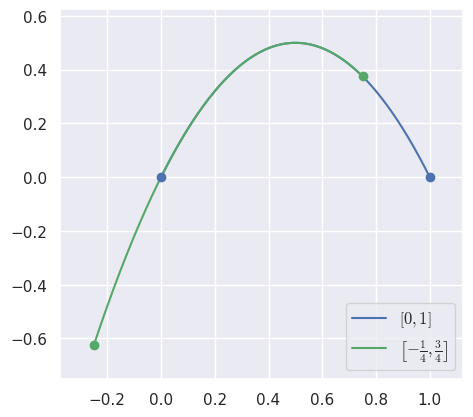
-
void
BEZ_subdivide_nodes_curve(const int *num_nodes, const int *dimension, const double *nodes, double *left_nodes, double *right_nodes)¶ Split a Bézier curve into two halves \(B\left(\left[0, \frac{1}{2}\right]\right)\) and \(B\left(\left[\frac{1}{2}, 1\right]\right)\).
- Parameters
num_nodes (const int*) – [Input] The number of control points \(N\) of a Bézier curve.
dimension (const int*) – [Input] The dimension \(D\) such that the curve lies in \(\mathbf{R}^D\).
nodes (const double*) – [Input] The actual control points of the curve as a \(D \times N\) array. This should be laid out in Fortran order, with \(D N\) total values.
left_nodes (double*) – [Output] The control points of the left half curve \(B\left(\left[0, \frac{1}{2}\right]\right)\) as a \(D \times N\) array, laid out in Fortran order.
right_nodes (double*) – [Output] The control points of the right half curve \(B\left(\left[\frac{1}{2}, 1\right]\right)\) as a \(D \times N\) array, laid out in Fortran order.
Signature:
void BEZ_subdivide_nodes_curve(const int *num_nodes, const int *dimension, const double *nodes, double *left_nodes, double *right_nodes);
Example:
For example, subdividing the curve \(B(s) = \left[\begin{array}{c} 0 \\ 0 \end{array}\right] (1 - s)^2 + \frac{1}{4} \left[\begin{array}{c} 5 \\ 12 \end{array}\right] 2 (1 - s) s + \left[\begin{array}{c} 2 \\ 1 \end{array}\right] s^2\):
// Inputs. int num_nodes = 3; int dimension = 2; double nodes[6] = { 0.0, 0.0, 1.25, 3.0, 2.0, 1.0 }; // Outputs. double left_nodes[6]; double right_nodes[6]; BEZ_subdivide_nodes_curve( &num_nodes, &dimension, nodes, left_nodes, right_nodes); printf("Left Nodes:\n"); printf("%f, %f, %f\n", left_nodes[0], left_nodes[2], left_nodes[4]); printf("%f, %f, %f\n", left_nodes[1], left_nodes[3], left_nodes[5]); printf("Right Nodes:\n"); printf("%f, %f, %f\n", right_nodes[0], right_nodes[2], right_nodes[4]); printf("%f, %f, %f\n", right_nodes[1], right_nodes[3], right_nodes[5]);
yields:
$ INCLUDE_DIR=.../libbezier-release/usr/include $ LIB_DIR=.../libbezier-release/usr/lib $ gcc \ > -o example \ > example_subdivide_nodes_curve.c \ > -I "${INCLUDE_DIR}" \ > -L "${LIB_DIR}" \ > -Wl,-rpath,"${LIB_DIR}" \ > -lbezier \ > -lm -lgfortran $ ./example Left Nodes: 0.000000, 0.625000, 1.125000 0.000000, 1.500000, 1.750000 Right Nodes: 1.125000, 1.625000, 2.000000 1.750000, 2.000000, 1.000000